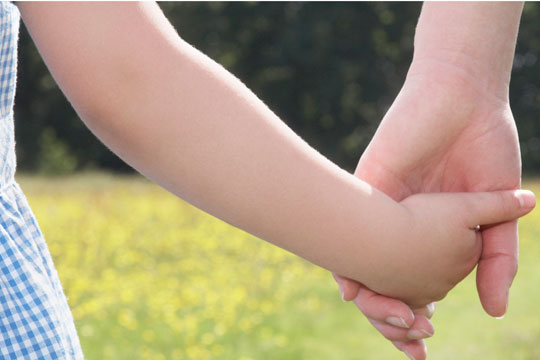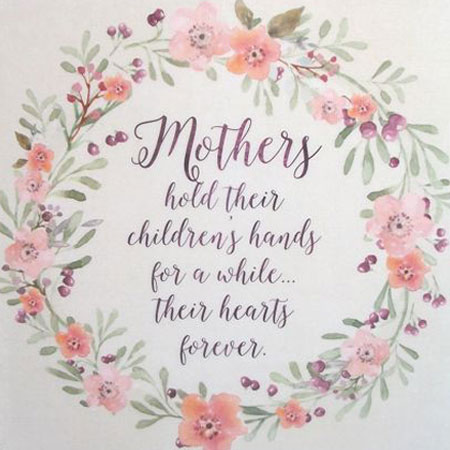 When I co-owned a home décor business, one of the products featured in our catalog was a calligraphy sign that said: Mothers hold their children’s hands for a while… their hearts forever. At the time, my kids were five and three, then eight and five, and twelve and nine—Lindsey and Michael practically grew up in the warehouse where I packed and shipped those sweetly framed pieces of art to our customers.
When I co-owned a home décor business, one of the products featured in our catalog was a calligraphy sign that said: Mothers hold their children’s hands for a while… their hearts forever. At the time, my kids were five and three, then eight and five, and twelve and nine—Lindsey and Michael practically grew up in the warehouse where I packed and shipped those sweetly framed pieces of art to our customers.
During those busy years, I adored holding my toddler’s, preschooler’s, and grade-schooler’s hands. They were so small, so soft, so innocent. I held them when we crossed streets, when we walked to the park, and sometimes, when I was driving down the road. I’d reach behind me to the backseat where the kids were safely buckled in and slip my palm into Lindsey’s or Michael’s. Without ever saying a word, we’d hold onto each other for a mile or two.
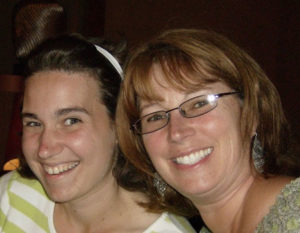
Last month, my thirty-seven-year-old daughter and I took an Oprah Winfrey cruise to Alaska. The last port on the itinerary was Victoria. We’d traveled there on Holland America ten years before, when my daughter was twenty-seven. Out of all the ports of call, Lindsey said she enjoyed this one most because at the end of that evening, we had taken a horse drawn carriage from the Empress Hotel back to the cruise ship. Lindsey grinned the entire ride. So, we were both looking forward to returning to this charming Canadian city and seeing a little more of the town.
As soon as we exited the ship and headed down the ramp of the MS Eurodam, Lindsey reached out to hold my hand. You see, back when my daughter was sixteen month’s old, she had a grand mal seizure. Afterwards, she developed essential tremors that caused her hands, arms, and head to shake. In 1986, doctors at Oregon Health Science diagnosed her with intellectual disabilities, explaining that a short in her neurological system causes information to process differently in her brain than in those of her more typical counterparts. They also predicted she would eventually live in a group home. Then in her late twenties, Lindsey began to suffer from balance and spatial issues that caused additional mobility problems.
Despite struggling daily, my daughter has proven the OHSU doctors wrong. Lindsey lives independently—in her own apartment— and she works a part-time job at a local State Farm Insurance agent’s office. Some days, Lindsey’s tremors are mild and anyone observing her might not even notice. Other days she fights to confidently take a single step—yet forces herself to take many. A few years ago, for a short period of time, Lindsey felt more comfortable using a walker to get around our small community. Lately, though, she’s graduated back to a cane. Some days, she doesn’t even need that.
Once we left the port area, I offered to hail a taxi to take us into town. Lindsey said she’d rather walk. That answer pleased me because the mile stroll along the waterfront—from the port into downtown Victoria—is delightful. Besides, my Fitbit indicated that I needed a lot more steps to reach my daily goal.
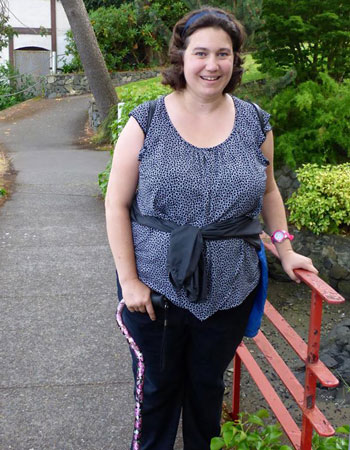 But as we headed down the sidewalks, the paved paths, the wooden walkway near the water, past the houseboats and the little boat taxi landing, unless Lindsey was gripping my hand, she took baby steps. It was as if her legs were frozen.
But as we headed down the sidewalks, the paved paths, the wooden walkway near the water, past the houseboats and the little boat taxi landing, unless Lindsey was gripping my hand, she took baby steps. It was as if her legs were frozen.
When I held my daughter’s hand, she moved at a fairly normal pace. When I let go, cruise ship passengers seemed to whizz past us as if they were running in a relay. Holding on tight, Lindsey stepped confidently. Letting go, my daughter moved slower than a sloth.
I know Lindsey cannot help this. At least I do not wish to believe she does this for attention. Although my mind did wander back to recent days on the cruise ship and how effectively Lindsey moved about the corridors with only her cane and no help from me. Still, I chose to consider, that on those unfamiliar streets, in that unfamiliar city, she needed to hold my hand.
As we walked, I thought back to the years when I treasured holding my little one’s hands. In most cases, it wasn’t a mandatory gesture—it was a way to connect, to let them know I was thinking about them. As children grow, though, most mothers hope their kids will let go of their hands and begin to navigate the world on their own.
Sauntering toward the Empress Hotel, holding my thirty-seven-year-old’s hand, I glimpsed someone staring at us, trying to assess our situation. My face flushed red. A rush of emotions surged through me. Envy. Why can’t we be like all the other mothers and daughters? Grief, then deep sadness. For Lindsey. She struggles so. And even though my brain comprehends that she can’t help having mobility issues, I felt embarrassed. Embarrassed to have to walk the sidewalks of Victoria hand-in-hand with a thirty-something woman—to stand out from the other mothers and daughters walking toward the town’s center. Then shame. Shame because I allowed myself to care what other people think, to permit untoward feelings in the first place.
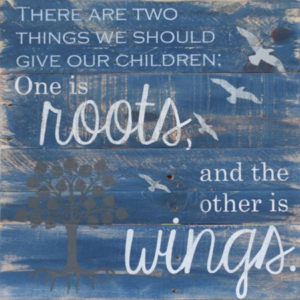 My mind somersaulted back in time, back to my warehouse where I also packed a wooden sign we carried: There are two things we should give our children. One is roots, and the other is wings.
My mind somersaulted back in time, back to my warehouse where I also packed a wooden sign we carried: There are two things we should give our children. One is roots, and the other is wings.
Why can’t my daughter have wings? my brain screamed, suddenly feeling angry and frustrated along with all those other emotions. We were surrounded by happy, chatty tourists, and yet, I felt lonely. When it comes to my daughter, after all my years of counseling, I know it is okay to feel a mixture of emotions. All emotions have value. There is no right or wrong way to feel. I took a deep breath. I released the air slowly. I turned toward my daughter.
“You’re doing good, Linds,” I said. She gripped my hand tighter. Her face concentrated on the path ahead. She steadied her cane on the pavement, took a step, lifted her other leg, and shifted her body forward—one slow movement at a time. I studied my girl. She definitely has roots, I thought. Independent roots. And she proves them again and again, day after day.
As I walked toward the city center holding my daughter’s hand, I knew she also has wings. Her wings may not allow her to fly as high as I’d initially hoped on the day she was born, but compared to what the OHSU doctors predicted back when she was six, my girl is soaring.
And, sometimes, whether it’s convenient or not, and whether I embrace it or not, Lindsey is going to need to hold my hand.
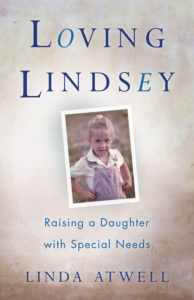
If you are interested in learning more about my book, Loving Lindsey: Raising a Daughter with Special Needs, click here.

